User:KLPeople/sandbox/apple silicon table
Appearance
Apple silicon A-series
[edit]| General | Image | Semiconductor technology |
Computer architecture |
CPU | GPU | AI accelerator | Memory technology |
First released date | Ultilizing devices | Supported OS | |||||||||||||||||||||||||||
|---|---|---|---|---|---|---|---|---|---|---|---|---|---|---|---|---|---|---|---|---|---|---|---|---|---|---|---|---|---|---|---|---|---|---|---|---|---|
| Name | Codename | Part No. | Node | Manufacturer | Transistors count | Die size | CPU ISA | Bit width | Performance core | Efficiency core | Overall core no. | Cache | Vendor | Core no. | EU count | ALU count | Frequency | FLOPS | Core no. | OPS | Memory bus width | Total channel Bit per channel |
Memory type | Theoretical bandwidth |
Available capacity | Initial | Terminal | ||||||||||
| Core name | Core no. | Core speed | Core name | Core no. | Core speed | L1 | L2 | L3 | SLC | ||||||||||||||||||||||||||||
| [a] | APL0098 | S5L8900 | 
|
90 nm [1] |
Samsung | 72 mm2 [2] |
ARMv6 | 32-bit | ARM11 | 1 | 412 MHz | — | — | — | Single-core | L1i: 16 KB L1d: 16 KB |
— | — | — | PowerVR MBX Lite | 1 | 1 | 8 | 60 MHz - 103 MHz | 0.96 GFLOPS - 1.64 FLOPS | — | — | 16-bit | 1 channel 16-bit/channel |
LPDDR-266 (133 MHz) |
533 MB/s | 128 MB | June 29, 2007 |
|
iPhone OS 1.0 | iPhone OS 3.1.3[b] iOS 4.2.1[c] | |
| [d] | APL0278 | S5L8720 | 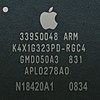
|
65 nm [2] |
36 mm2 [2] |
533 MHz | 103 MHz - 133 MHz | 1.64 GFLOPs - 2.12 GFLOPS | 32-bit | 1 channel 32-bit/channel |
1066 MB/s | September 9, 2008 |
|
iPhone OS 2.1.1 | |||||||||||||||||||||||
| [e] | APL0298 | S5L8920 | 
|
71.8 mm2 [3] |
ARMv7 | Cortex-A8 | 600 MHz | L1i: 32 KB L1d: 32 KB |
256 KB | PowerVR SGX535[4] | 2 | 16 | 200 MHz | 6.4 GFLOPS | LPDDR-400 (200 MHz) |
1.6 GB/s | 256 MB | June 19, 2009 | iPhone OS 3.0 | iOS 6.1.6 | |||||||||||||||||
| APL2298 | S5L8922 | 
|
45 nm [2][3][5] |
41.6 mm2 [2] |
September 9, 2009 |
|
iPhone OS 3.1.1 | iOS 5.1.1 | |||||||||||||||||||||||||||||
| A4 | APL0398 | S5L8930 | 
|
53.3 mm2 [2][3] |
800 MHz | 512 KB | 200 MHz - 250 MHz | 6.4 GFLOPS - 8.0 GFLOPS | 64-bit | 2 channels 32-bit/channel |
3.2 GB/s | April 3, 2010 |
|
iPhone OS 3.2 Apple TV Software 4.0 |
iOS 6.1.6 | ||||||||||||||||||||||
| 1.0 GHz |
|
iOS 5.1.1[f] Apple TV Software 6.2.1 | |||||||||||||||||||||||||||||||||||
| 800 MHz | 512 MB | iOS 7.1.2 | |||||||||||||||||||||||||||||||||||
| A5 | APL0498 | S5L8940 | 
|
122.2 mm2 [5] |
Cortex-A9 | 2 | 800 MHz | Dual-core | 1 MB | PowerVR SGX543[6][7] | 2 | 4 | 32 | 200 MHz | 12.8 GFLOPS | LPDDR2-800 (400 MHz) |
6.4 GB/s | March 11, 2011 | iOS 4.3 | iOS 9.3.5[g] iOS 9.3.6[h] Apple TV Software 7.6.2 | |||||||||||||||||
| 1.0 GHz |
| ||||||||||||||||||||||||||||||||||||
| APL2498 | S5L8942 | 
|
32 nm Hκ MG [8][9] |
69.6 mm2 [8] |
800 MHz | March 7, 2012 | iOS 5.1 | ||||||||||||||||||||||||||||||
| 1.0 GHz |
| ||||||||||||||||||||||||||||||||||||
| 2 (One core locked) | Dual-core Single-core in actual |
|
Apple TV Software 5.0 | ||||||||||||||||||||||||||||||||||
| APL7498 | S5L8947 | 
|
37.8 mm2 [9] |
1 | Single-core | January 28, 2013 |
|
Apple TV Software 5.2 | |||||||||||||||||||||||||||||
| A5X | APL5498 | S5L8945 | 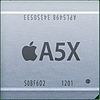
|
45 nm [2][3][5] |
165 mm2 [10] |
2 | Dual-core | 4 | 8 | 64 | 25.6 GFLOPS | 128-bit | 4 channels 32-bit/channel |
12.8 GB/s | 1 GB | March 16, 2012 | iOS 5.1 | ||||||||||||||||||||
| A6 | APL0598 | S5L8950 | 
|
32 nm Hκ MG [11][12][13] |
96.71 mm2 [11][12] |
ARMv7s[14] | Swift[15] | 1.3 GHz[16] | 3 | 6 | 48 | 266 MHz | 68.0 GFLOPS | 64-bit | 2 channels 32-bit/channel |
LPDDR2-1066 (533 MHz) |
8.5 GB/s | September 21, 2012 | iOS 6.0 | iOS 10.3.3[i] iOS 10.3.4[j] | |||||||||||||||||
| A6 | APL5598 | S5L8955 | 
|
123 mm2 [13] |
1.4 GHz[17] | PowerVR SGX554[17][18] | 4 | 16 | 128 | 300 MHz | 76.8 GFLOPS | 128-bit | 4 channels 32-bit/channel |
17.0 GB/s | November 2, 2012 | ||||||||||||||||||||||
| A7 | APL0698 | S5L8960 | 
|
28 nm Hκ MG [19][20] |
1 billion | 102 mm2 [21][20] |
ARMv8.0-A [22][23] |
64-bit | Cyclone | 1.3 GHz | L1i: 64 KB L1d: 64 KB |
4 MB (Inclusive) [22][24][25] |
PowerVR G6430[26][18] | 450 MHz | 115.2 GFLOPS | 64-bit | 1 channel 64-bit/channel |
LPDDR3-1600 (800 MHz) |
12.8 GB/s | September 20, 2013 | iOS 7.0 | iOS 12.5.5 | |||||||||||||||
| APL5698 | S5L8965 | 
|
1.4 GHz | November 1, 2013 |
|
iOS 7.0.3 | |||||||||||||||||||||||||||||||
| A8 | APL1011 | T7000 | 
|
20 nm Hκ MG[27][23] |
TSMC | 2 billion | 89 mm2 [28][29] [30] |
Typhoon | 1.1 GHz | PowerVR GX6450[31][32][33] | 533 MHz | 136.4 GFLOPS | September 19, 2014 | iOS 8.0 | |||||||||||||||||||||||
| 1.4 GHz | |||||||||||||||||||||||||||||||||||||
| audioOS 11.0 | HomePod Software 15.4 (Current) | ||||||||||||||||||||||||||||||||||||
| 1.5 GHz | 2 GB | iOS 8.0 tvOS 9.0 |
iOS 15.4 (Current) iPadOS 15.4 (Current) tvOS 15.4 (Current) | ||||||||||||||||||||||||||||||||||
| A8X | APL1021 | T7001 | 
|
3 billion | 128 mm2 [29] |
3 | 1.5 GHz | 3-core | 2 MB | PowerVR GX6850[31][29][30] | 8 | 32 | 256 | 450 MHz | 230.4 GFLOPS | 128-bit | 2 channels 64-bit/channel |
25.6 GB/s | October 22, 2014 | iOS 8.1 | |||||||||||||||||
| A9 | APL0898 | S8000 | 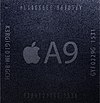
|
14 nm FinFET[34] |
Samsung | ≥ 2 billion | 96 mm2 [35] |
Twister | 2 | 1.85 GHz[36][37] | Dual-core | 3 MB | 4 MB (Victim) | PowerVR GT7600[31][39] | 6 | 24 | 192 | 650 MHz | 249.6 GFLOPS | 64-bit | 1 channel 64-bit/channel |
LPDDR4-3200 (1600 MHz) |
September 25, 2015 | iOS 9.0 | |||||||||||||
| APL1022 | S8003 | 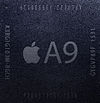
|
16 nm FinFET[35][40][41] |
TSMC | 104.5 mm2 [35] | ||||||||||||||||||||||||||||||||
| A9X | APL1021 | S8001 | 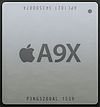
|
≥ 3 billion | 143.9 mm2 [40][42] |
2.16 GHz[43][44] | —[24][40] | PowerVR GT7850[31][40] | 12 | 48 | 384 | 650 MHz | 499.2 GFLOPS | 128-bit (64-bit in actual) |
2 channels (one channel is unused) 64-bit/channel |
November 11, 2015 |
|
iOS 9.1 | |||||||||||||||||||
| 2.26 GHz | 128-bit | 2 channels 64-bit/channel |
51.2 GB/s | 4 GB |
| ||||||||||||||||||||||||||||||||
| A10 Fusion | APL1W24 | T8010 | 
|
3.3 billion | 125 mm2 [41] |
ARMv8.1-A | Hurricane | 2 | 1.64 GHz | Zephyr | 2 | 1.09 GHz | Quad-core (Only 2 cores performed at a same time) |
P-core: L1i: 64 KB L1d: 64 KB E-core: L1i: 32 KB L1d: 32KB |
P-core: 3 MB E-core: 1 MB |
4 MB | PowerVR GT7600 Plus[45][31][46][47] | 6 | 24 | 192 | 900 MHz | 345.6 GFLOPS | 64-bit | 1 channel 64-bit/channel |
25.6 GB/s | 2 GB | September 16, 2016 | iOS 10.0 | |||||||||
| 2.34 GHz | |||||||||||||||||||||||||||||||||||||
| 3 GB | |||||||||||||||||||||||||||||||||||||
| A10X Fusion | APL1071 | T8011 | 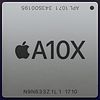
|
10 nm FinFET [42] |
≥ 4 billion | 96.4 mm2 [42] |
3 | 2.38 GHz | 3 | 1.30 GHz | 6-core (Only 3 cores performed at a same time) |
P-core: 8 MB E-core: 1 MB |
—[48][49] | 4 MB | 12 | 48 | 384 | 1000 MHz | 768.0 GFLOPS | 128-bit | 2 channels 64-bit/channel |
51.2 GB/s | 3 GB | June 13, 2017 | tvOS 11.0 | ||||||||||||
| 4 GB | iOS 10.3.2 | ||||||||||||||||||||||||||||||||||||
| A11 Bionic | APL1W72 | T8015 | 
|
4.3 billion | 87.66 mm2 [50] |
ARMv8.2-A[51] | Monsoon | 2 | 2.39 GHz | Mistral | 4 | 1.19 GHz | 6-core | First generation Apple-designed | 3 | 24 | 192 | 1066 MHz | 409.3 GFLOPS | 2 | 600 billion OPS | 64-bit | 1 channel 64-bit/channel |
LPDDR4X-4266 (2133 MHz) |
34.1 GB/s | 2 GB | September 22, 2017 | iOS 11.0 | |||||||||
| 3 GB | |||||||||||||||||||||||||||||||||||||
| A12 Bionic | APL1W81 | T8020 | 
|
7 nm FinFET (N7) | 6.9 billion | 83.27 mm2 [52] |
ARMv8.3-A[53] | Vortex | 2.49 GHz | Tempest | 1.59 GHz | P-core: L1i: 128 KB L1d: 128 KB E-core: L1i: 32 KB L1d: 32KB |
P-core: 8 MB E-core: 2 MB |
8 MB | Second generation Apple-designed | 4 | 32 | 256 | 1125 MHz | 576.0 GFLOPS | 8 | 5 TOPS | September 21, 2018 | iOS 12.0 tvOS 14.5 | |||||||||||||
| 4 GB | |||||||||||||||||||||||||||||||||||||
| A12X Bionic | APL1083 | T8027 | 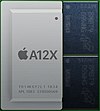
|
10 billion | 135 mm2 [54] |
4 | 8-core | 7 |
56 | 448 | 1340 MHz | 1.20 TFLOPS | 128-bit | 2 channels 64-bit/channel |
68.2 GB/s | November 7, 2018 | iOS 12.1 | ||||||||||||||||||||
| 6 GB | |||||||||||||||||||||||||||||||||||||
| A12Z Bionic | 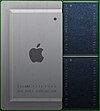
|
8 | 64 | 512 | 1.37 TFLOPS | March 25, 2020 | iPadOS 13.4 | ||||||||||||||||||||||||||||||
| 16 GB | June 22, 2020 | macOS Big Sur 11.0 Beta 1 | macOS Big Sur 11.3 Beta 2 | ||||||||||||||||||||||||||||||||||
| A13 Bionic | APL1W85 | T8030 | 
|
7 nm FinFET (N7P) | 8.5 billion | 98.48 mm2 [55] |
ARMv8.4-A[56] | Lightning | 2 | 2.65 GHz | Thunder | 1.80 GHz | 6-core | P-core: L1i: 192 KB L1d: 128 KB E-core: L1i: 96 KB L1d: 48 KB |
P-core: 8 MB E-core: 4 MB |
16 MB | Third generation Apple-designed[57] | 4 | 32 | 256 | 1350 MHz | 691.2 GFLOPS | 5.5 TOPS | 64-bit | 1 channel 64-bit/channel |
34.1 GB/s | 3 GB | September 20, 2019 | iOS 13.0 iPadOS 13.0 |
iOS 15.4 (Current) iPadOS 15.4 (Current) tvOS 15.4 (Current) | |||||||
| 4 GB | |||||||||||||||||||||||||||||||||||||
| A14 Bionic | APL1W01 | T8101 | 
|
5 nm FinFET (N5) | 11.8 billion | 88 mm2 [58] |
ARMv8.5-A | Firestorm | 3.09 GHz | Icestorm | 1.82 GHz | P-core: L1i: 192 KB L1d: 128 KB E-core: L1i: 128 KB L1d: 64 KB |
Fourth generation Apple-designed[59][57][60][61] | 64 | 512 | 1000 MHz | 1.0 TFLOPS | 16 | 11 TOPS | October 23, 2020 | iOS 14.0 iPadOS 14.0 | ||||||||||||||||
| 6 GB | |||||||||||||||||||||||||||||||||||||
| A15 Bionic | APL1W07 [62] |
T8110 | 
|
5 nm FinFET (N5P) | 15 billion | 107.68 mm2[62] | Avalanche | 3.23 GHz | Blizzard | 2.02 GHz | P-core: 12 MB E-core: 4 MB |
32 MB | Fifth generation Apple-designed[63][64][65][66][67] | 128 | 1024 | 600 MHz | 1.2 TFLOPS | 15.8 TOPS | 4 GB | September 24, 2021 | iOS 15.0 iPadOS 15.0 | ||||||||||||||||
| 2.93 GHz | 5 | 160 | 1280 | 1.5 TFLOPS | |||||||||||||||||||||||||||||||||
| 3.23 GHz | 6 GB | ||||||||||||||||||||||||||||||||||||
| Name | Codename | Part No. | Image | Node | Manufacturer | Transistors count | Die size | CPU ISA | Bit width | Core name | Core no. | Core speed | Core name | Core no. | Core speed | Overall core no. | L1 | L2 | L3 | SLC | Vendor | Core no. | EU count | ALU count | Frequency | FLOPS | Core no. | OPS | Memory bus width | Total channel Bit per channel |
Memory type | Theoretical bandwidth |
Available capacity | First released date | Ultilizing devices | Initial | Terminal |
| Performance core | Efficiency core | Cache | |||||||||||||||||||||||||||||||||||
| General | Semiconductor technology |
Computer architecture |
CPU | GPU | AI accelerator | Memory technology |
Supported OS | ||||||||||||||||||||||||||||||
Apple silicon M-series
[edit]| General | Image | Semiconductor technology |
Computer architecture |
CPU | GPU | AI accelerator | Memory technology |
Connectivity | First released date | Ultilizing devices | Supported OS | ||||||||||||||||||||||||||||||
|---|---|---|---|---|---|---|---|---|---|---|---|---|---|---|---|---|---|---|---|---|---|---|---|---|---|---|---|---|---|---|---|---|---|---|---|---|---|---|---|---|---|
| Name | Codename | Part No. | Node | Manufacturer | Transistors count | Die size | CPU ISA | Bit width | Performance core | Efficiency core | Overall core no. | Cache | Vendor | Core no. | EU count | ALU count | Frequency | FLOPS | Core no. | OPS | Memory bus width | Total channel Bit per channel |
Memory type | Theoretical bandwidth |
Available capacity | Ports | External display | Initial | Terminal | ||||||||||||
| Core name | Core no. | Core speed | Core name | Core no. | Core speed | L1 | L2 | L3 | SLC | Thunderbolt | USB | Max no. | |||||||||||||||||||||||||||||
| M1 | APL1102 | T8103 | 
|
5 nm FinFET (N5) | TSMC | 16 billion | 120 mm2 [68] |
ARMv8.5-A | 64-bit | Firestorm | 4 | 3.20 GHz | Icestorm | 4 | 2.06 GHz | 8-core | P-core: L1i: 192 KB L1d: 128 KB E-core: L1i: 128 KB L1d: 64 KB |
P-core: 12 MB E-core: 4 MB |
— | 16 MB | Fourth generation Apple-designed | 7 | 112 | 896 | 1278 MHz | 2.29 TFLOPS | 16 | 11 TOPS | 128-bit | 2 channels 64-bit/channel |
LPDDR4X-4266 (2133 MHz) |
68.2 GB/s | 8 GB 16 GB[k] |
Thunderbolt 3 (Up to 40 Gbps)[l] |
USB4 (Up to 40 Gbps)[m] USB 3.1 Gen 2 (Up to 10 Gbps) |
iPad: 1 Thunderbolt/USB4[n] MacBook and Mac Desktop: 2 Thunderbolt/USB4 iMac: Additional 2 USB-C Mac mini: Additional 2 USB-A and 1 HDMI 2.0 |
All: One 6016 x 3384 at 60 Hz at 8-bit color depth display Mac mini: Additional One 4096 x 2160 at 60 Hz at 8-bit color depth display |
November 17, 2020 |
|
macOS Big Sur 11.0 iPadOS 14.5 |
macOS Monterey 12.3 (Current) iPadOS 15.4 (Current) |
| 8 | 128 | 1024 | 2.61 TFLOPS |
| |||||||||||||||||||||||||||||||||||||
| M1 Pro | APL1103 | T6000 | 
|
33.7 billion | ≈ 245 mm2 [68] |
6 | 3.23 GHz | 2 | P-core: 24 MB E-core: 4 MB |
32 MB | 14 | 224 | 1792 | 1296 MHz | 4.58 TFLOPS | 256-bit | 2 channels 128-bit/channel |
LPDDR5-6400 (3200 MHz) |
204.8 GB/s | 16 GB 32 GB[o] |
Thunderbolt 4 (Up to 40 Gbps) |
MacBook: 3 Thunderbolt 4, 1 SDXC slot and 1 HDMI 2.0 |
Two 6016 x 3384 at 60 Hz at 10-bit color depth displays | October 26, 2021 |
|
macOS Monterey 12.0 | macOS Monterey 12.3 (Current) | ||||||||||||||
| 8 | 10-core | ||||||||||||||||||||||||||||||||||||||||
| 16 | 256 | 2048 | 5.30 TFLOPS |
| |||||||||||||||||||||||||||||||||||||
| M1 Max | APL1105[69] | T6001 | 
|
57 billion | ≈ 432 mm2 [68] |
64 MB | 24 | 384 | 3072 | 7.83 TFLOPS | 512-bit | 4 channels 128-bit/channel |
409.6 GB/s | 32 GB 64 GB[p] |
MacBook: 3 Thunderbolt 4, 1 SDXC slot and 1 HDMI 2.0 Mac Studio: 4 Thunderbolt 4, 2 USB-C, 1 SDXC slot and 1 HDMI 2.0 |
MacBook: Three 6016 x 3384 at 60 Hz at 10-bit color depth displays and one 4096 x 2160 at 60 Hz at 8-bit color depth display Mac Studio: Four 6016 x 3384 at 60 Hz at 10-bit color depth displays and one 4096 x 2160 at 60 Hz at 8-bit color depth display |
| ||||||||||||||||||||||||
| 32 | 512 | 4096 | 10.6 TFLOPS | ||||||||||||||||||||||||||||||||||||||
| M1 Ultra | APL1W06 | 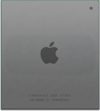
|
114 billion | ≈ 864 mm2 | 16 | 4 | 20-core | P-core: 48 MB E-core: 8 MB |
128 MB | 48 | 768 | 6144 | 15.7 TFLOPS | 32 | 22 TOPS | 1024-bit | 8 channels 128-bit/channel |
819.2 GB/s | 64 GB 128 GB[q] |
6 Thunderbolt 4, 1 SDXC slot and 1 HDMI 2.0 | Four 6016 x 3384 at 60 Hz at 10-bit color depth displays and one 4096 x 2160 at 60 Hz at 8-bit color depth display |
March 18, 2022 |
|
macOS Monterey 12.3 | |||||||||||||||||
| 64 | 1024 | 8192 | 21.2 TFLOPS | ||||||||||||||||||||||||||||||||||||||
| Name | Codename | Part No. | Image | Node | Manufacturer | Transistors count | Die size | CPU ISA | Bit width | Core name | Core no. | Core speed | Core name | Core no. | Core speed | Overall core no. | L1 | L2 | L3 | SLC | Vendor | Core no. | EU count | ALU count | Frequency | FLOPS | Core no. | OPS | Memory bus width | Total channel Bit per channel |
Memory type | Theoretical bandwidth |
Available capacity | Thunderbolt | USB | Max no. | External display | First released date | Ultilizing devices | Initial | Terminal |
| Performance core | Efficiency core | Cache | Ports | ||||||||||||||||||||||||||||||||||||||
| General | Semiconductor technology |
Computer architecture |
CPU | GPU | AI accelerator | Memory technology |
Connectivity | Supported OS | |||||||||||||||||||||||||||||||||
Cite error: There are <ref group=lower-alpha> tags or {{efn}} templates on this page, but the references will not show without a {{reflist|group=lower-alpha}} template or {{notelist}} template (see the help page).
- ^ Shimpi, Anand Lal (June 10, 2009). "The iPhone 3GS Hardware Exposed & Analyzed". AnandTech. Archived from the original on June 14, 2017. Retrieved September 13, 2013.
- ^ a b c d e f g Cite error: The named reference
EETimes-A4was invoked but never defined (see the help page). - ^ a b c d Cite error: The named reference
Chipworks-A4was invoked but never defined (see the help page). - ^ Wiens, Kyle (April 5, 2010). "Apple A4 Teardown". iFixit. Step 20. Archived from the original on August 10, 2013. Retrieved April 15, 2010.
cIt's quite challenging to identify block-level logic inside a processor, so to identify the GPU we're falling back to software: early benchmarks are showing similar 3D performance to the iPhone, so we're guessing that the iPad uses the same PowerVR SGX 535 GPU.
- ^ a b c Cite error: The named reference
Chipworks-A5was invoked but never defined (see the help page). - ^ Shimpi, Anand Lal (Sep 2012). "The iPhone 5 Performance Preview". AnandTech. Archived from the original on December 29, 2012. Retrieved October 24, 2012.
- ^ Cite error: The named reference
AnandTechDieShotwas invoked but never defined (see the help page). - ^ a b Cite error: The named reference
Chipworks-A5R2was invoked but never defined (see the help page). - ^ a b Cite error: The named reference
Chipworks-A5-singlecorewas invoked but never defined (see the help page). - ^ Cite error: The named reference
Chipworks-A5Xwas invoked but never defined (see the help page). - ^ a b Cite error: The named reference
Chipworks-A6was invoked but never defined (see the help page). - ^ a b "Apple A6 Teardown". iFixit. September 25, 2012. Archived from the original on June 18, 2020. Retrieved June 19, 2020.
- ^ a b Cite error: The named reference
Chipworks-A6Xwas invoked but never defined (see the help page). - ^ "Xcode 6 drops armv7s". Cocoanetics. October 10, 2014. Archived from the original on October 10, 2018. Retrieved October 9, 2018.
- ^ Shimpi, Anand Lal (September 15, 2012). "The iPhone 5's A6 SoC: Not A15 or A9, a Custom Apple Core Instead". AnandTech. Archived from the original on December 29, 2012. Retrieved September 15, 2012.
- ^ "The iPhone 5 Performance Preview". AnandTech. Archived from the original on December 29, 2012. Retrieved November 1, 2012.
- ^ a b Cite error: The named reference
AnandTech-iPad4GPUwas invoked but never defined (see the help page). - ^ a b Lai Shimpi, Anand (October 29, 2013). "The iPad Air Review: GPU Performance". AnandTech. Archived from the original on November 1, 2013. Retrieved October 30, 2013.
- ^ Cite error: The named reference
Chipworks-iPhone5swas invoked but never defined (see the help page). - ^ a b "Inside the iPad Air". Chipworks. November 1, 2013. Archived from the original on May 8, 2015. Retrieved November 12, 2013.
- ^ Cite error: The named reference
AnandTech-iPhone5s-64-bitwas invoked but never defined (see the help page). - ^ a b Cite error: The named reference
AnandTech-iPhone5s-Cyclonewas invoked but never defined (see the help page). - ^ a b Cite error: The named reference
A8was invoked but never defined (see the help page). - ^ a b c "Correcting Apple's A9 SoC L3 Cache Size: A 4MB Victim Cache". AnandTech. November 30, 2015. Archived from the original on December 1, 2015. Retrieved December 1, 2015.
- ^ Cite error: The named reference
AnandTech-iPadAir-CPUwas invoked but never defined (see the help page). - ^ Cite error: The named reference
AnandTech-iPhone5s-GPUwas invoked but never defined (see the help page). - ^ Cite error: The named reference
A8: Applewas invoked but never defined (see the help page). - ^ "Apple's A8 SoC analyzed". ExtremeTech. September 10, 2014. Archived from the original on September 11, 2014. Retrieved September 11, 2014.
- ^ a b c Cite error: The named reference
Apple A8Xwas invoked but never defined (see the help page). - ^ a b "Imagination PowerVR GXA6850 - NotebookCheck.net Tech". NotebookCheck.net. November 26, 2014. Archived from the original on November 29, 2014. Retrieved November 26, 2014.
- ^ a b c d e Cite error: The named reference
:0was invoked but never defined (see the help page). - ^ "Chipworks Disassembles Apple's A8 SoC: GX6450, 4MB L3 Cache & More". AnandTech. September 23, 2014. Archived from the original on September 23, 2014. Retrieved September 23, 2014.
- ^ "Imagination PowerVR GX6450". NOTEBOOKCHECK. September 23, 2014. Archived from the original on September 25, 2014. Retrieved September 24, 2014.
- ^ Ho, Joshua (September 9, 2015). "Apple Announces the iPhone 6s and iPhone 6s Plus". Archived from the original on September 10, 2015. Retrieved September 10, 2015.
- ^ a b c "Apple's A9 SoC Is Dual Sourced From Samsung & TSMC". Anandtech. September 28, 2015. Archived from the original on September 30, 2015. Retrieved September 29, 2015.
- ^ "iPhone 6s customer receives her device early, benchmarks show a marked increase in power". iDownloadBlog. September 21, 2015. Archived from the original on September 24, 2015. Retrieved September 25, 2015.
- ^ "A9's CPU: Twister - The Apple iPhone 6s and iPhone 6s Plus Review". AnandTech. November 2, 2015. Archived from the original on January 18, 2016. Retrieved November 4, 2015.
- ^ "Inside the iPhone 6s". Chipworks. September 25, 2015. Archived from the original on February 3, 2017. Retrieved September 26, 2015.
- ^ "A9's GPU: Imagination PowerVR GT7600 - The Apple iPhone 6s and iPhone 6s Plus Review". AnandTech. November 2, 2015. Archived from the original on November 5, 2015. Retrieved November 4, 2015.
- ^ a b c d "More on Apple's A9X SoC: 147mm2@TSMC, 12 GPU Cores, No L3 Cache". AnandTech. November 30, 2015. Archived from the original on December 1, 2015. Retrieved December 1, 2015.
- ^ a b techinsights.com. "Apple iPhone 7 Teardown". www.chipworks.com. Archived from the original on September 16, 2016. Retrieved September 16, 2016.
- ^ a b c Cite error: The named reference
TechInsights-A10Xwas invoked but never defined (see the help page). - ^ "The A9X SoC & More To Come - The iPad Pro Preview: Taking Notes With iPad Pro". AnandTech. November 11, 2015. Archived from the original on November 13, 2015. Retrieved November 11, 2015.
- ^ "iPad Pro review: Mac-like speed with all the virtues and restrictions of iOS". AnandTech. November 11, 2015. Archived from the original on November 11, 2015. Retrieved November 11, 2015.
- ^ "Intel Core i5-8250U vs Apple A10 Fusion". GadgetVersus. Archived from the original on December 27, 2019. Retrieved December 27, 2019.
- ^ "iPhone 7 GPU breakdown". Wccftech. December 2016. Archived from the original on December 5, 2016. Retrieved February 1, 2017.
- ^ Agam Shah (December 2016). "The mysteries of the GPU in Apple's iPhone 7 are unlocked". PC World. Archived from the original on January 28, 2017. Retrieved February 1, 2017.
- ^ Cite error: The named reference
AnandTech-A10Xwas invoked but never defined (see the help page). - ^ "Measured and Estimated Cache Sizes". AnandTech. October 5, 2018. Archived from the original on October 6, 2018. Retrieved October 6, 2018.
- ^ "Apple iPhone 8 Plus Teardown". TechInsights. September 27, 2017. Archived from the original on September 27, 2017. Retrieved September 28, 2017.
- ^ "Apple A11 New Instruction Set Extensions" (PDF). Apple Inc. June 8, 2018. Archived (PDF) from the original on October 8, 2018. Retrieved October 9, 2018.
- ^ "Apple iPhone Xs Max Teardown". TechInsights. September 21, 2018. Archived from the original on September 21, 2018. Retrieved September 21, 2018.
- ^ "Apple A12 Pointer Authentication Codes". Jonathan Levin, @Morpheus. September 12, 2018. Archived from the original on October 10, 2018. Retrieved October 9, 2018.
- ^ "The Packaging of Apple's A12X is… Weird". Dick James of Chipworks. January 16, 2019. Archived from the original on January 29, 2019. Retrieved January 28, 2019.
- ^ "Apple iPhone 11 Pro Max Teardown | TechInsights". www.techinsights.com. Archived from the original on September 27, 2019. Retrieved September 27, 2019.
- ^ "A13 has ARMv8.4, apparently (LLVM project sources, thanks, @Longhorn)". Jonathan Levin, @Morpheus. March 13, 2020. Archived from the original on March 10, 2020. Retrieved March 13, 2020.
- ^ a b Cross, Jason (October 14, 2020). "A14 Bionic FAQ: What you need to know about Apple's 5nm processor". Macworld. Retrieved April 2, 2021.
- ^ Patel, Dylan (October 27, 2020). "Apple's A14 Packs 134 Million Transistors/mm², but Falls Short of TSMC's Density Claims". SemiAnalysis. Retrieved October 29, 2020.
- ^ Cite error: The named reference
Frumusanuwas invoked but never defined (see the help page). - ^ "All-new iPad Air with advanced A14 Bionic chip available to order starting today". Apple. October 16, 2020.
- ^ Frumusanu, Andrei (September 15, 2020). "Apple Announces new 8th gen iPad with A12, iPad Air with 5nm A14 Chip". Anandtech. Retrieved April 7, 2021.
- ^ a b "Apple iPhone 13 Pro Teardown | TechInsights". www.techinsights.com.
- ^ Sohail, Omar (September 16, 2021). "iPhone 13 With 4-Core GPU Scores Significantly Less Than iPhone 13 Pro; Only 15 Percent Higher Than iPhone 12 Pro". Wccftech. Retrieved September 17, 2021.
- ^ "Discover advances in Metal for A15 Bionic - Tech Talks - Videos".
- ^ Roberts (September 18, 2021). "Discover advances in Metal for A15 Bionic". developer.apple.com. Retrieved November 12, 2021.
- ^ Sohail (September 15, 2021). "iPhone 13 Pro With 5-Core GPU Obtains a Remarkable 55 Percent Performance Increase Over iPhone 12 Pro". wccftech. Retrieved September 19, 2021.
- ^ Roberts (September 18, 2021). "Discover advances in Metal for A15 Bionic". developer.apple.com. Retrieved November 12, 2021.
- ^ a b c Frumusanu, Andrei (October 18, 2021). "Apple Announces M1 Pro & M1 Max: Giant New Arm SoCs with All-Out Performance". AnandTech.
- ^ APL1105 from @VadimYuryev on Twitter

